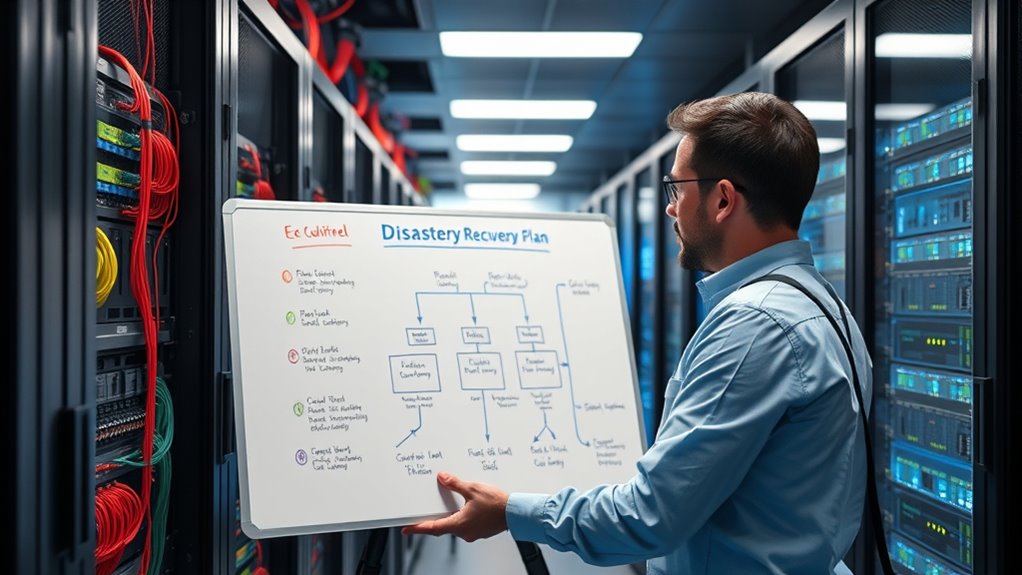To create a disaster recovery plan for network cabling, start by evaluating your facility’s specific risks and vulnerabilities. Implement cabling redundancy with multiple pathways and backup connections to prevent single points of failure. Regularly inspect, maintain, and secure your cabling with high-quality materials and protective measures. Elevate cables in flood-prone areas and reinforce key routes. Combining these strategies with clear procedures will help you swiftly recover from outages—discover more ways to safeguard your network.
Key Takeaways
- Develop a comprehensive inventory of all cabling assets and critical network components.
- Implement cabling redundancy with multiple pathways and backup connections for critical areas.
- Conduct regular inspections, maintenance, and use durable, protected cabling materials to prevent damage.
- Identify facility-specific risks and employ targeted mitigation strategies like flood barriers and secure conduits.
- Establish clear procedures for quick response, cable switching, and recovery to minimize downtime during outages.

Having a solid disaster recovery plan for your network cabling is essential to guarantee quick restoration and minimize downtime after unforeseen events. One of the most effective ways to achieve this is through cabling redundancy. By designing your network with multiple pathways and backup connections, you ensure that if one cable or pathway fails, your network can seamlessly switch to an alternative. Implementing redundant cabling routes in critical areas prevents single points of failure, allowing your business to maintain operations even during physical damage or accidental disconnections. This approach not only speeds up recovery but also reduces the risk of prolonged outages that could impact productivity and revenue.
In addition to cabling redundancy, damage prevention strategies play a crucial role in safeguarding your network infrastructure. Regular inspections and proactive maintenance can identify vulnerabilities before they escalate into failures. Using high-quality, durable cabling materials and protective conduits shields your cables from physical threats like accidental impacts, water leaks, or pests. It’s also vital to secure cable pathways with proper enclosures and access controls to prevent tampering or accidental damage by personnel. Employing fire-resistant and weatherproof cabling options further enhances resilience against environmental hazards. You should also consider implementing cable management best practices, such as organizing cables neatly and labeling them clearly, to facilitate quick troubleshooting and reduce the likelihood of accidental disconnections or damage during maintenance.
Planning for damage prevention involves evaluating your facility’s specific risks and tailoring your strategies accordingly. For instance, if your network runs through areas prone to flooding, elevating cabling routes or installing flood barriers can be effective. In high-traffic zones, reinforced conduits or protective coverings can prevent accidental cuts or abrasions. Educating staff on the importance of cable safety and establishing protocols for handling and inspecting cabling can also markedly lower the chances of damage. Additionally, integrating fire detection and suppression systems nearby can protect your cabling in case of fire outbreaks, further minimizing the risk of network outages caused by physical damage.
Ultimately, a comprehensive disaster recovery plan for your network cabling combines redundancy with proactive damage prevention. By investing in multiple pathways, high-quality protective measures, and regular maintenance, you create a resilient infrastructure capable of withstanding various threats. This approach ensures your network remains operational, even when unforeseen disruptions occur, enabling you to recover swiftly and keep your business running smoothly. The key is to stay vigilant, continually assess potential vulnerabilities, and adapt your strategies accordingly—because in network management, prevention and preparedness are your best defenses against downtime.
Frequently Asked Questions
How Often Should We Update Our Network Cabling Disaster Recovery Plan?
You should update your network cabling disaster recovery plan at least annually, aligning with your maintenance schedule and technology updates. Regular reviews ensure you address new vulnerabilities, incorporate hardware or software changes, and adapt to evolving business needs. Additionally, update after any significant network changes or incidents. Staying proactive helps you minimize downtime and maintain network resilience, ensuring your recovery plan remains effective and thorough over time.
What Are the Key Components to Include in the Plan?
Imagine your business experiences a cable outage; your plan should include cable redundancy to guarantee minimal downtime. You must incorporate vendor contacts for quick replacements and repairs, detailed step-by-step procedures for restoring service, and clear roles and responsibilities. Additionally, include inventory details, testing procedures, and communication protocols. Regularly updating these components ensures your recovery plan remains effective, reducing downtime and maintaining network integrity during disruptions.
How Do We Prioritize Cabling Recovery During a Disaster?
You should prioritize cabling recovery during a disaster by focusing on critical areas first, such as main data centers and server rooms. Use cabling prioritization to identify essential connections that support business continuity. Incorporate this into your disaster response plan, ensuring rapid restoration of indispensable network links. Clear communication and predefined procedures help streamline the process, minimizing downtime and restoring operations efficiently.
What Training Is Necessary for Staff to Execute the Plan Effectively?
Imagine your team unexpectedly faces a network outage—being prepared makes all the difference. You need to train staff on emergency procedures to boost their competency in disaster scenarios. Focus on hands-on drills, clear communication protocols, and troubleshooting techniques. Regularly update training to reflect plan changes. This guarantees everyone knows their role, reacts swiftly, and minimizes downtime, ultimately safeguarding your network infrastructure during unforeseen crises.
How Can We Test the Effectiveness of Our Disaster Recovery Plan?
You can test your disaster recovery plan’s effectiveness by conducting regular simulation exercises that mimic real-world failures, helping your team practice response actions. Additionally, perform vulnerability assessments to identify weaknesses in your network cabling infrastructure. These methods guarantee your plan is practical and robust, revealing gaps that need addressing, so you’re prepared to restore operations quickly and minimize downtime during actual emergencies.
Conclusion
By implementing a solid disaster recovery plan for your network cabling, you’re safeguarding your entire business from chaos. Remember, a single broken cable can cause more disruption than a hurricane—don’t wait until it’s too late. Stay proactive, test your plan regularly, and keep backups ready. With these steps, you’ll be prepared to bounce back faster than you ever thought possible, ensuring your network stays strong no matter what disaster strikes.





